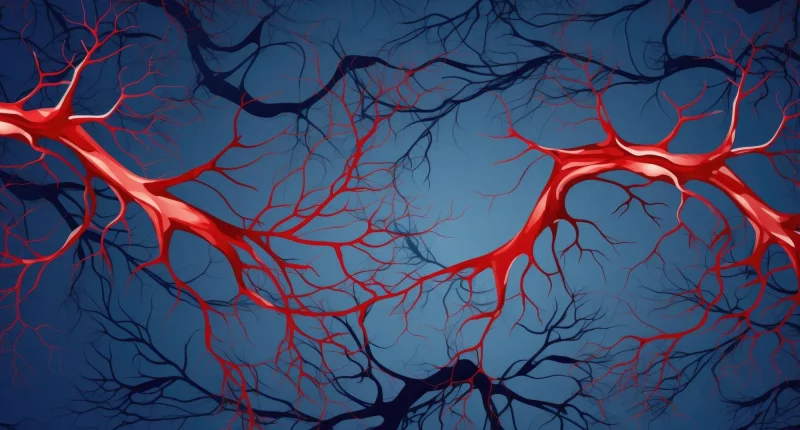An aneurysm happens when a part of an artery becomes weak and starts to bulge out. This can happen in any artery in your body. Most of the time, aneurysms don’t cause any symptoms and aren’t harmful. But if an aneurysm bursts, it can cause very serious internal bleeding that might be deadly.
To put it simply, an aneurysm is like a weak spot in a balloon that makes it swell up.
The Centers for Disease Control and Prevention (CDC) says that more than 25,000 people in the United States die each year because of aortic aneurysms. These are aneurysms that occur in the aorta, the main artery that carries blood from the heart to the rest of the body.
Additionally, about 30,000 brain aneurysms rupture in the U.S. each year. When a brain aneurysm bursts, it can be very dangerous, with around 40% of these cases resulting in death within a day.
Types of Aneurysms
Aneurysms are categorized based on their location in the body, with the brain and heart being the most common sites for serious aneurysms. These bulges in blood vessels can take two main shapes: fusiform aneurysms, which bulge on all sides of a blood vessel, and saccular aneurysms, which bulge on only one side. The risk of an aneurysm rupturing depends on the proportion of the bulge.
Aortic Aneurysm
The aorta, the large artery starting at the left ventricle of the heart and extending through the chest and abdomen, normally measures between 2 and 3 cm in diameter. However, an aneurysm can cause it to bulge to over 5 centimeters. The most regular type of aortic aneurysm is an abdominal aortic aneurysm (AAA), occurring in the area of the aorta that follows across the abdomen. Without operation, the annual survival rate for an AAA larger than 6 cm is only 20 percent. AAAs can quickly become deadly, but those who make it to the hospital have 50-50 chances to survive.
Another type of aortic aneurysm is the thoracic aortic aneurysm (TAA), which affects the area of the aorta following across the chest. TAAs are less common, accounting for only 25 percent of aortic aneurysms. Without medication, the survival rate for TAA is 56 percent, but with surgery, it improves to 85 percent.
Cerebral Aneurysm
Aneurysms in the arteries supplying the brain with blood are called intracranial or “berry” aneurysms due to their appearance. A ruptured brain aneurysm can be life-threatening within 24 hours. About 40 percent of these ruptures are deadly, and about 66 percent of survivors suffer from neurological impairments or disabilities. Ruptured cerebral aneurysms are the leading cause of a kind of stroke called subarachnoid hemorrhage (SAH).
Peripheral Aneurysms
Aneurysms can also develop in peripheral arteries, including:
- Popliteal aneurysm takes place behind the knee, the most frequent type of peripheral aneurysm.
- Splenic artery aneurysm happens near the spleen.
- Mesenteric artery aneurysm occurs in the artery supplying blood to the intestines.
- Femoral artery aneurysm happens in the groin area.
- Carotid artery aneurysm takes place in the neck.
- Visceral aneurysms happen in the arteries supplying blood to the bowel or kidneys.
Peripheral aneurysms are generally less likely to rupture compared to aortic aneurysms.
Treatment of Aneurysms
Not all unruptured aneurysms require immediate treatment. However, when an aneurysm ruptures, emergency surgery is required to save the patient’s life.
Aortic Aneurysm Treatment Options
For unruptured aortic aneurysms, doctors might choose to monitor the condition if there are no symptoms. This monitoring can include regular check-ups and imaging tests to keep an eye on the aneurysm’s size and growth. Along with observation, doctors may prescribe medications and recommend lifestyle changes to manage the condition and reduce the risk of rupture.
If an aortic aneurysm ruptures, emergency surgery is essential. Without quick surgical intervention, the chances of survival are very low.
Factors Influencing Surgery for Unruptured Aneurysms
- The patient’s age, overall health, other existing medical conditions, and personal preferences.
- The size of the aneurysm, its location in the chest (thorax) or abdomen, and how quickly it is growing.
- Symptoms like chronic lower stomach pain or the risk of blood clots (thromboembolism), which may also require surgery.
Larger or rapidly developing aneurysms are more likely to require surgical intervention.
Surgical Options for Aortic Aneurysms
There are two main types of surgery for aortic aneurysms:
- Open Surgery: This involves making a large incision in the abdomen to open the aorta. The surgeon then places a synthetic graft to repair the aneurysm.
- Endovascular Surgery: This is a less invasive procedure where the surgeon makes a small incision close to the hip and uses a catheter to insert a stent graft into the aorta. The stent graft is positioned to reinforce the artery and seal off the aneurysm.
Risks of Endovascular Surgery
Endovascular surgery carries several risks, including:
- Bleeding near the graft
- Bleeding pre- or post-surgery
- Stent blockage
- Nerve damage, leading to pain, weakness, or numbness in the leg
- Kidney damage
- Decreased blood supply to the kidneys, legs, or other organs
- Erectile disorder
- The possibility of needing further open surgery if the initial procedure is unsuccessful
- Stent slippage
In some cases, complications like bleeding near the graft may require additional surgery to correct.
Symptoms
Most aneurysms don’t show any symptoms and are often found incidentally during medical exams for other reasons. Symptoms typically arise when an aneurysm ruptures, which can be life-threatening.
Even if an aneurysm hasn’t ruptured, it can still cause problems by obstructing blood flow to other tissues or forming blood clots. These blood clots can travel and block smaller blood vessels, leading to a condition called thromboembolism. This can result in serious problems like an ischemic stroke.
- Abdominal Aneurysms: Sometimes, a rapidly developing abdominal aneurysm can cause symptoms. Individuals with abdominal aneurysms might experience lower back pain, abdominal pain, or a pulsating feeling in the abdomen.
- Thoracic Aneurysms: These can affect blood vessels and nerves, causing symptoms such as difficulty swallowing and breathing, as well as pain in the chest, jaw, and upper back.
The underlying reason for an aneurysm can also produce symptoms. For example, an aneurysm caused by vasculitis, which is inflammation of the blood vessels, may lead to symptoms such as fever, general discomfort (malaise), or weight loss.
Causes of Aneurysms
An aneurysm can take place anywhere in your body. It occurs when the pressure of blood stretches out a weak spot in an artery wall.
Researchers are still studying why artery walls weaken and lead to aneurysms. They are although less common, are there from birth due to a defect in the artery.
Aortic Dissection
One known cause of aortic aneurysms is aortic dissection. The artery linings have three layers, and when there’s a tear, blood can burst through, breaking these layers. This can create a cavity around the heart. If the tear is in the innermost layer, blood can weaken the wall, improving the chance of rupture.
Individuals with aortic dissection frequently feel sudden and serious chest pain that can spread along the aorta, possibly to the back. This dissection can compress the heart, making it hard for blood to return to it, which is called pericardial tamponade.
Risk Factors
Certain lifestyle choices and physical traits can raise your chances of getting an aneurysm:
- Smoking: Smoking is the most common risk factor, especially for abdominal aortic aneurysms (AAA). It not only increases the risk of getting an aneurysm but also makes it more likely to burst.
- High Blood Pressure: Having high blood pressure increases the strain on artery walls.
- Poor Diet and Inactivity: Not eating well and not being active can make your arteries weaker.
- Obesity: Being overweight can also put more pressure on your arteries.
Diagnosis of Aneurysms
Aneurysms are often hard to spot without specific tests. Screening tests are done to find people who might need treatment or careful watching.
The US Preventive Services Task Force (USPSTF) suggests that men aged around 65 to 75 years who have smoked at least 100 cigarettes in their lives should get an ultrasound screening for signs of abdominal aortic aneurysm (AAA). This helps catch any issues early.
However, routine screening isn’t recommended for women because they have a lower risk of AAA, regardless of whether they smoked or not.
Diagnostic Tests
- MRI Scan: If someone shows symptoms, like sudden severe pain, an MRI scan can find an aneurysm before it bursts.
- CT Scan: CT scans are often used for ruptured aneurysms, especially if there’s a risk of bleeding in the brain. It gives detailed images of the inside of the body.
- Angiogram: In cases where emergency surgery is needed for a serious or ruptured aneurysm in the heart or brain, an angiogram can pinpoint the correct area that needs fixing. During this procedure, a catheter is put into a blood vessel in the thigh, and it’s guided to the affected area. A special dye is used to highlight the problem area, helping the doctor know where to focus the treatment.
Prevention of Aneurysms
Preventing all aneurysms isn’t always possible since some are present from birth.
- Quit Smoking: Smoking increases the risk of aneurysms and their rupture. Ceasing smoking can lower this chance significantly.
- Manage Blood Pressure: Keeping blood pressure in check is essential. This can be done through a healthy diet, regular exercise, and treatment if needed.
- Maintain a Healthy Weight: Obesity adds stress to the heart and artery walls. Keeping a healthy weight can reduce this pressure.
- Healthy Diet: Eating well can lower cholesterol and reduce the chance of atherosclerosis, which is often associated with fusiform aneurysms.
If someone is diagnosed with an aneurysm and given a treatment plan, they should work closely with their doctor to point out any risk factors. This collaboration can help manage the condition effectively.
Summary
While preventing all aneurysms may not be feasible, adopting healthy lifestyle choices can significantly reduce the risk of developing and experiencing complications from these potentially life-threatening conditions. Strategies such as quitting smoking, managing blood pressure, maintaining a healthy weight, and following a nutritious diet can play crucial roles in preventing aneurysms and promoting overall cardiovascular health.
Additionally, regular screenings, particularly for high-risk individuals, can aid in early detection and timely intervention. By actively addressing risk factors and collaborating with healthcare providers, individuals can take proactive steps toward minimizing the impact of aneurysms on their health and well-being.









